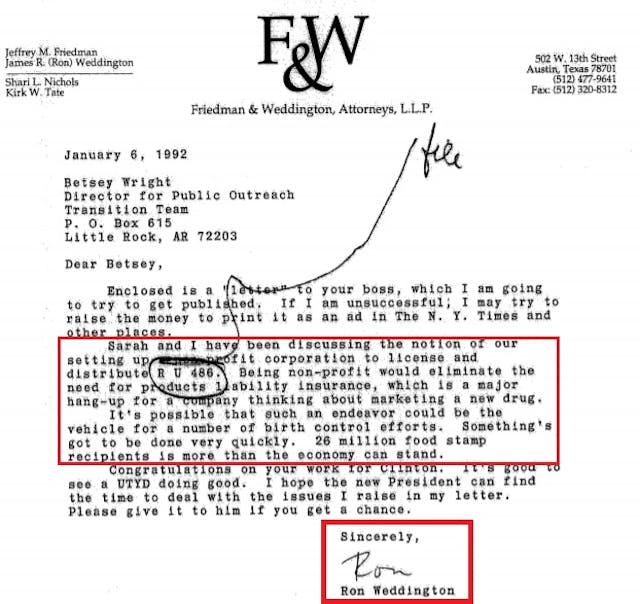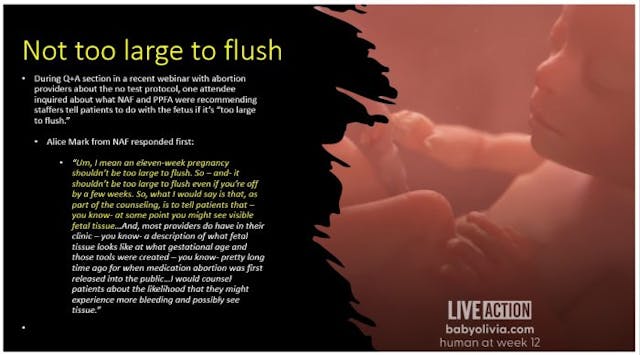
Abortion activist secures removal of pro-life billboards in British Columbia
Bridget Sielicki
·
Abortion Pill·By Carole Novielli
How Big Abortion avoids responsibility and buries abortion pill complications
As Big Abortion offloads its medical responsibility onto women who purchase the abortion pill, those women are expected to function as their own doctor, nurse, and pathologist in so-called “self-managed” mail-order abortions. Additionally, in an apparent deceptive scheme to hide adverse abortion pill outcomes, abortion profiteers also advise women experiencing serious complications to present to the emergency room (ER) and lie about the cause of those complications.
This, of course, helps no one but the industry itself.
When things go wrong, women do not end up at the door of the prescriber, who is clear of any responsibility for the patient’s care, but in the ER.
Secrecy vs. Safety
The abortion pill has now ended the lives of an estimated 7.5 million preborn babies, with safeguards removed in recent years, allowing the drug to expand from in-person dispensing and follow-up care to a ‘no-test’ protocol. This led to mail-order and telehealth access. With each step, Big Abortion made the case that the pill was “safe.”
The Food and Drug Administration’s (FDA) move to weaken important safety requirements on the abortion pill, allowing it to be dispensed by mail, caused the skyrocketing growth of unregulated virtual abortion pill dispensaries. Despite the mifepristone (200mg) label’s black box warning about the risk of sepsis, online dispensaries openly admit to spending less than five minutes assessing clients and do “little to no counseling or follow-up.”
Claims of the drug’s “safety” simply cannot be trusted.
Over the past 25 years, an incestuous abortion pill funding trail has led from investors in abortion pill manufacturers Danco Laboratories and GenBioPro to various “consultants,” groups, location sites, and sponsors behind abortion pill clinical trials and studies which claim to show the abortion pill’s safety and effectiveness. Several industry spokespersons and study authors who claim the abortion pill is “safe” have disclosed being on the payroll of Danco/GenBioPro, signaling potential conflicts of interest.
The FDA has never disclosed the identities of the experts who reviewed the original studies relied upon for the abortion drug’s approval, and has seemingly done nothing to rein in those who flout the drug’s REMS safety requirements by prescribing it past the approved gestational limit and dispensing it to women who are not pregnant.
Even Danco, the drug’s name-brand manufacturer, has been shrouded in secrecy, with undisclosed manufacturing locations — until 2023, when a Department Of Justice (DOJ) False Claims Act settlement fined Danco just under $800,000 for allegedly illegally withholding information about Mifeprex’s manufactured country of origin. This forced Danco to reveal on drug packaging that in 2025, the drug was being manufactured in Spain.
During initial trials, the media was stunned at the amount of secrecy surrounding the abortion pill; today, the media sticks to the talking points of abortion insiders, even hiding their ties to the abortion pill manufacturer and investors.
Those who originally approved the drug in the U.S. are still kept secret — today, 25 years after the fact. “In return for working with the drug, companies wanted confidentiality. The FDA and the Population Council, in an unusual move, agreed to provide the desired secrecy,” wrote author Julie A. Hogan.
An “anonymous” FDA senior medical reviewer also admitted, “It’s definitely not standard” for that sort of secrecy surrounding a drug’s approval.
Until the full record on this approval process is revealed, the American public should continue to question the purported safety of self-managed abortion.
The Beginning: Abortion Pill Rooted in Eugenics
The abortion pill, originally referred to as RU-486, was developed by a company with connections to the creators of the Zyklon-B gas used to exterminate victims of the Nazi Holocaust. Read more here.
A 1991 book published by three pro-abortion researchers suggested that the abortion pill was developed to “restrict population growth in countries that were judged to be ‘underdeveloped,'” and that “If successful, the method(s) could be extended to groups in the United States, Black, Hispanic and Native American Women.” This is eugenics in action.

Roe v. Wade co-counsel Ron Weddington (ex-husband of pro-Roe attorney Sarah Weddington) wrote in 1992 to the newly-elected Clinton administration, expressing concern about the growth of certain population groups. He suggested the elimination of certain societal groups via vasectomies, tubal ligations, abortions, and the abortion pill (emphasis added):
Sarah and I have been discussing the notion of our setting up [a non] profit corporation to license and distribute RU486. It’s possible that such an endeavor could be the vehicle for a number of birth control efforts. 26 million food stamp recipients is more than the economy can stand.
In 1994, the Clinton administration pushed for marketing and distribution rights of the abortion pill in the U.S. to be given to the Population Council (founded by John D. Rockefeller III in 1952), along with others already entrenched in the eugenics movement. The drug’s distribution was later transferred to Danco Laboratories, a sub-licensee of the Population Council.

More recently, it was research group Gynuity Health Projects — funded by organizations with historic ties to the American eugenics movement — which conducted abortion pill clinical trials to help eliminate the FDA’s in-person safety requirements. Gynuity’s president and founder, Beverly Winikoff, M.D., previously served as Assistant Director for Health Sciences at the Rockefeller Foundation. According to author Edwin Black, that Foundation “helped found the German eugenics program and even funded the program that Josef Mengele worked in before he went to Auschwitz.”
Article continues below
Dear Reader,
In 2026, Live Action is heading straight where the battle is fiercest: college campuses.
We have a bold initiative to establish 100 Live Action campus chapters within the next year, and your partnership will make it a success!
Your support today will help train and equip young leaders, bring Live Action’s educational content into academic environments, host on-campus events and debates, and empower students to challenge the pro-abortion status quo with truth and compassion.
Invest in pro-life grassroots outreach and cultural formation with your DOUBLED year-end gift!
Winikoff once called the abortion pill a “world shaking” technological advancement, saying, “I feel like people must have felt when they discovered the nuclear bomb” — apparently missing the dark irony of the destructive comparison.
Shortly after the abortion pill was approved in 2000, deaths began to be reported, causing the manufacturer to issue letters of warning to healthcare professionals. But the news of the first woman to die related to the abortion pill was overshadowed by the attacks on September 11, 2001. Gynuity‘s Winikoff (employed by the Population Council at the time of 9/11) later claimed that 9/11 “saved” the abortion pill because the woman’s death was no longer front page news. Winikoff left the Population Council to found Gynuity in 2003.
Modern Day: ‘No-Test’ = No Safeguards
Prior to Roe v. Wade, abortion advocates portrayed so-called self-abortions as dangerous. But once Big Abortion began toying with the idea of ‘no-test’ abortion pill protocols and mail-order telabortion schemes (including an over-the-counter abortion pill push), suddenly, self-managed abortion became “safe.”
Today, Big Abortion is unconcerned about the harms of self-managed abortions, keeping silent as underground abortion pill vigilantes and ‘shadow networks‘ assemble abortion pills stored on ping-pong tables and shipped from basements, where they could be laced with any number of harmful substances.
In 2020, when the abortion industry implemented the ‘no-test’ protocol, it did so despite openly admitting that ‘no-test’ “criteria are not going to rule out every ectopic pregnancy.” The abortion industry decided that ectopic pregnancies could be dealt with after the woman begins the abortion pill regimen and reports back that she is still pregnant — assuming there is any follow-up at all.
There are many problems with this flippancy — time is of the essence, given that an ectopic pregnancy grown inside the mother’s fallopian tube can rupture and become fatal if not caught in time. And the abortion industry, by its own admission, does not follow-up with every abortion pill client.
The industry was also unconcerned about respecting the FDA’s 10-week gestational limits. Abortion pill risks increase as gestational age increases — a fact made clear by the manufacturer’s own medication guides. Yet, in a webinar recorded during the COVID-19 pandemic, National Abortion Federation medical director Alice Mark seemed indifferent about verifying the gestational age of the fetus unless the baby might be too large to flush:
… [A]n eleven-week pregnancy shouldn’t be too large to flush… even if you’re off by a few weeks. So, what I would say is that, as part of the counseling, is to tell patients that – you know — at some point you might see visible fetal tissue…
Women self-managing their abortions have been advised to sit on a toilet and flush their dead child into the sewer system. As a result, women have been traumatized by seeing the recognizable body parts of the babies they have aborted.
Lawsuits against abortion providers reveal that abortion drugs are prescribed well into the second and third trimester. One abortion client alleged that she drove the body of her dead 30-week son back to the facility that sold her abortion drugs only to be told “not to call law enforcement.”

Even long-time late-term abortionist Warren Hern was disturbed by this apparent recklessness. (Hern retired and shuttered his facility in early 2025.) In 1986, he began to publish skepticism about the drug, and 10 years later, he suggested to the New York Times that “some within the abortion rights movement had exaggerated the drug regimen’s ease of use while glossing over its side effects….”
In 2024, Hern again questioned the care women receive when they are sold abortion pills. “My issue with medication abortion is—is there a follow-up exam? Do you know if the uterus is empty or not? Who’s going to take care of them if there’s a complication?” Hern asked the New Yorker.
The answer was clear: women would be left to visit an ER or urgent care instead of the prescriber.
But no one would necessarily know about even serious complications; 2016 changes put in place by the Obama administration’s FDA no longer mandated Danco or GenBioPro to notify the FDA of adverse events (complications) other than death.
Burying Adverse Outcomes
Authors of a recent insurance data analysis claim that abortion pill complications seen in real-world data versus clinical data are 22 times greater than what has been previously reported.
Data on the FDA’s 2023 mifepristone label acknowledged that 2.9 to 4.6% of women who take the drug require emergency care, and six percent (6%) who took the abortion pill in a telehealth study required emergency care. The manufacturer’s medication guide notes up to 7 % of women will “need a surgical procedure” to complete the abortion.
Danco and the FDA always understood that ERs would be necessary to treat abortion pill clients, even as the FDA allowed for the expansion of “self-managed” and “mail-order” abortion. When you add to this bad actors in the industry who instruct women to go to the ER for complications (instead of to the prescriber) and even suggest that ER staff should falsify medical documents to cover up abortion pill complications, that amounts to a coordinated attempt to bury the truth.
The drug’s safety protocols require a prescriber to have the ability to diagnose an ectopic pregnancy and determine gestational age. But since anyone with a computer, phone, and Fed-Ex account can now become an abortion profiteer, this protocol is being broken, and clients have nowhere else to go but the ER for help when something goes wrong.
Prescribers who abandon their patients to overcrowded ERs may never know about adverse events — including the reportable deaths — and they will continue claiming that the drug is “safe.”
Live Action News is pro-life news and commentary from a pro-life perspective.
Contact editor@liveaction.org for questions, corrections, or if you are seeking permission to reprint any Live Action News content.
Guest Articles: To submit a guest article to Live Action News, email editor@liveaction.org with an attached Word document of 800-1000 words. Please also attach any photos relevant to your submission if applicable. If your submission is accepted for publication, you will be notified within three weeks. Guest articles are not compensated (see our Open License Agreement). Thank you for your interest in Live Action News!

Bridget Sielicki
·
Abortion Pill
Carole Novielli
·
Abortion Pill
Bridget Sielicki
·
Abortion Pill
Carole Novielli
·
Abortion Pill
Bridget Sielicki
·
Abortion Pill
Bridget Sielicki
·
Abortion Pill
Carole Novielli
·
Investigative
Carole Novielli
·
Human Rights
Carole Novielli
·
Abortion Pill
Carole Novielli
·
Investigative
Carole Novielli
·